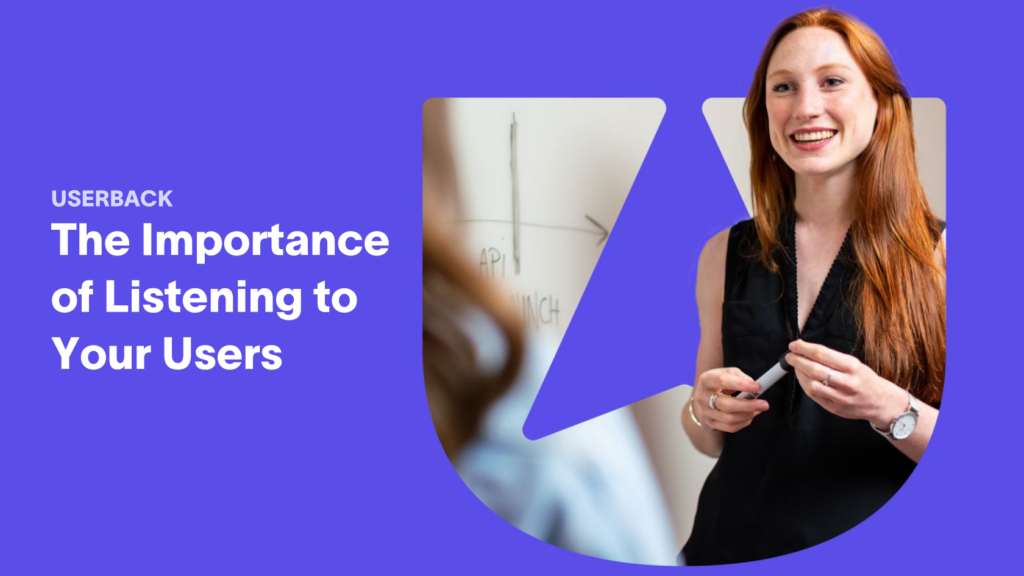Listening to users is essential for any company that wants to put users at the center of their product in the hopes of increasing market fit and driving new revenue and delighting existing customers in order to reduce churn.
The concept of user-centered product design has long been established, but the formal concept has yet to make its way into what Userback terms user-centered product development continuously adopting user feedback to inform product development priorities from initial build, to future iteration and maintenance mode. Historically software teams have found that continuous user feedback loops are difficult to master and maintain, but in today’s world it doesn’t need to be.
So why should you prioritize user feedback and make the shift to user-centered product development if you haven’t already?
Firstly, and most obviously, listening to users can help you understand their needs and wants by accessing directly what they say about your product. Today, with modern tooling you can categorize and prioritize using user feedback to make changes to your product roadmap to address those most common needs improving product over time.
Needs and wants leads to (ongoing) market fit
It makes sense to assume getting user feedback can help you build a product to address the needs and wants communicated. Perhaps what is less understood is the flow-on impact to your market fit, the degree to which your product satisfies a strong market demand. Market fit isn’t just about the initial step in establishing a new product or venture, it’s a continuously moving target as markets evolve and user preferences change accordingly. Monitoring that market feed through continuous user feedback is key to staying aligned with that evolving set of user needs.
Staying on top of your changing market encourages product adoption as users find what they’re looking for from a feature set and leads to revenue growth for organizations, innovation and competitive advantages over competitors and an ability to reduce development cost through focus to maximize profitability. Reducing the development costs isn’t the only way to maximize profitability however, achieving market fit through user feedback also improves the perceived value from your users, which can facilitate pricing increases without a mass customer exodus. If a user believes your product is worth more because of its ability to deliver, it’s well proven they’re willing to pay more to have access to it.
Why listening to users is important for reducing churn rate
Getting a new user is only half the battle, sustainable businesses are built on customer growth, low customer churn rates, long customer lifecycles, and profitability along the way. By listening to user feedback, organizations can address the second element in that success equation and reduce churn rate as the feedback they gather is key to understanding user needs and making changes to fill the gaps users require to succeed.
If you’re able to prioritize the most common feature requests and most impactful bug fixes and add those elements into your development roadmap first, you’re able to address and amend any shortfalls users perceive that may lead them to test alternative options. Users that adopt and integrate a product that evolves with them and continues to satisfy the vast majority of their needs (understanding it’s very unlikely a single product is going to be 100% perfect at every use case a user every envisages) is going to remain loyal for a number of years, extending total lifetime value for a business.
Of course, listening to user feedback isn’t enough; there needs to be a process put in place around collected feedback to ensure what’s being listened to is also being screened, prioritized, integrated into workflows and actioned. Optimally in this scenario, there is an additional step of creating two-way feedback so users who are requesting feature requests. Listening without action doesn’t contribute to user-centered product development.
More than listening
Feedback once collected should be classified into categories suited to your business – that may be UX/UI, bug fixes, feature requests so each can be prioritized and allocated to the correct teams effectively.
These categorized feedback pieces should also be ranked in order of submission rate. Fixing the first bug that is reported may be a poor use of Developers time relative to other pieces of feedback which indicate more users running into a specific issue. By stack ranking, feedback can be used to optimize product roadmaps and zero in on user feedback that matters most to the market.
Having categorized and prioritized feedback based submission rate, feedback needs to be integrated into the workflows and tools that developers use, feedback can’t be isolated in additional tools where individuals have to search for it. Product Managers or those responsible for listening to user feedback and actioning need to put it directly into systems in use – that may mean Jira, Asana, Monday.com or any other well known board (product integrations play a key role here with user feedback platforms).
The last part to listening to your user feedback, is to provide an outlet to demonstrate to users you’re hearing them, from feedback to action can take some time- weeks to months generally, and feedback that goes into a black hole (from the submitters perspective) can cause some to lose heart, potentially adding to user churn from those who feel they have no voice. Part of listening is acknowledging, and organizations should consider feedback portals where users can track the submissions made by themselves or other users in a sort of user request roadmap. This is a powerful tool in creating an invested user community and optimal market fit.
To sum it up, listening to user feedback is essential for any company that wants to drive growth and reduce its churn rate. By understanding what users want and need from your product, you can make changes to address their pain points and keep them using your product making it more valuable to users and less likely they will churn. Modern feedback platforms available today can assist in simplifying feedback collection and streamlining the additional steps needed to make it meaningful across categorization, prioritization, screening and integration into existing workflows for action.
Don’t forget to complete the feedback loop and connect back with users though!
If you want to get closer to your user base by harnessing user feedback, days like 20,000 software teams have already done. From collecting to action, Userback can streamline your process and close the feedback loop.


